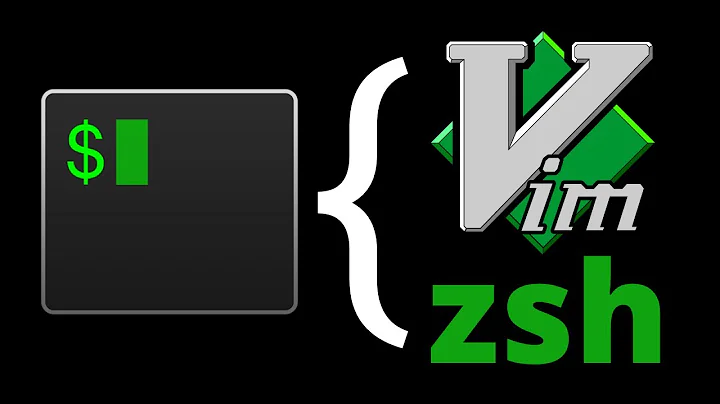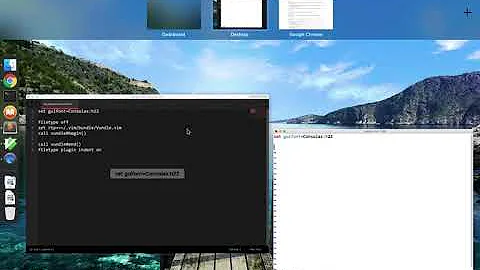How to run mvim (MacVim) from Terminal?
Solution 1
There should be a script named mvim in the root of the .bz2 file. Copy this somewhere into your $PATH ( /usr/local/bin would be good ) and you should be sorted.
Solution 2
I don't think I'd to add anything to the path, did
brew install macvim
mvim -v
should then open macvim in the terminal, you can also go ahead and alias that
alias vim='mvim -v'
Solution 3
If you go the brew route, the best way to install would be:
brew install macvim --with-override-system-vim
That will provide mvim, vim, vi, view, etc. in /usr/local/bin (all symlinked to the copy in the Cellar). This also removes the need to create any aliases and also changes your vi, vim, etc. to all use the same Vim distribution as your MacVim.
Solution 4
In addition, if you want to use MacVim (or GVim) as $VISUAL or $EDITOR, you should be aware that by default MacVim will fork a new process from the parent, resulting in the MacVim return value not reaching the parent process. This may confuse other applications, but Git seems to check the status of a temporary commit message file, which bypasses this limitation. In general, it is a good practice to export VISUAL='mvim -f' to ensure MacVim will not fork a new process when called, which should give you what you want when using it with your shell environment.
Solution 5
If you already have macVim installed: /Applications/MacVim.app/Contents/MacOS/Vim -g will give you macVim GUI.
just add an alias.
i use gvim because that is what i use on linux for gnome-vim.
alias gvim='/Applications/MacVim.app/Contents/MacOS/Vim -g'
Related videos on Youtube
Fred
Updated on November 08, 2020Comments
-
Fred over 3 years
I have MacVim installed and I am trying to set it up as the editor for Git (version control), but I can't run 'mvim' from the command line as it isn't recognised. How do I setup mvim so I can run it from Terminal?
-
pavium over 14 yearsTry
vimfrom the command-line. -
laura over 14 yearsDisclaimer: this would work for Linux so I suppose it is similar on a Mac. Try to see the path (use "
echo $PATH") and add the folder to the MacVim executable to it if it's not there already (use "export PATH=$PATH:path/to/folder"). Mind the$signs, they are important!
-
-
Fred over 14 yearsThanks I'll give this a go. I installed MacVim and Git using the UI installers. But its looking like Macports is the way to go.
-
Slava Nadvorny almost 14 yearsDon't use mac port versions unless you absolutely need to. It installs all the dependency libraries ignoring darwin native ones. This can i.e. replace your perl 5.10 with 5.8 in path etc. Check homebrew (brew) system instead.
-
jnthnclrk about 13 yearsWhere do you find the bz2 file?
-
Gordon Robertson about 13 yearsA year ago that was what you got when you downloaded MacVim. Now it's a.tbz file, but the script is still there.
-
Aaron Lake over 12 yearsAnyone reading this today using homebrew you'll have to run
brew linkappsafter installing macvim. -
davetapley about 12 yearsWhilst the
--override-system-vimdid create some of the symlinks for me, it failed to override/usr/bin/vimand/usr/bin/viand so I still had to manuallyaliasthese in my.profile. -
Jason Yanowitz about 12 yearsDave, that sounds like a PATH problem, /usr/local/bin needs to be first in your PATH. This answer, pointing at brew, should be the number one answer, as it gets you everything you need.
-
 Admin about 12 years@SlavaNadvorny maybe true when this was written. I currently have a development environment with MacVim, scipy, haskell, multiple versions of erlang, python and perl all functioning properly with macports. The same was not possible with brew (at this time this was written). I do like brew's non-sudo install and wished it worked in this case.
Admin about 12 years@SlavaNadvorny maybe true when this was written. I currently have a development environment with MacVim, scipy, haskell, multiple versions of erlang, python and perl all functioning properly with macports. The same was not possible with brew (at this time this was written). I do like brew's non-sudo install and wished it worked in this case. -
Michael Durrant about 12 yearsI also can't find where macvim or the bz2 file is
-
Michael Durrant about 12 yearsTried this but it didn't work for me. VIM_APP_DIR=~/Downloads/MacVim-snapshot-64/MacVim.app $ mvim -v x.x Sorry, cannot find MacVim.app. Try setting the VIM_APP_DIR environment variable to the directory containing MacVim.app.
-
Andrew over 11 yearsfyi running
brew doctorshould notify you of any PATH or configuration issues for brew. -
 tltjr over 11 yearsYou can locate the file by using find from your root directory.
tltjr over 11 yearsYou can locate the file by using find from your root directory.sudo find . -name mvimMine was in /Applications/MacVim-snapshot-64/mvim. -
user4581301 over 11 years
mvimcan also be had directly from source. -
Brad Parks over 11 yearsSince mvim is simply a shell script, you can download it directly from the MacVim source at GitHub here: raw.github.com/b4winckler/macvim/master/src/MacVim/mvim
-
Bryan Head over 11 yearsThe '-v' option works if you've installed from source or from download as well as shown in other answers.
-
mk12 almost 11 years
brew linkapps --systemif you want it in your /Applications folder. -
studgeek almost 11 yearsIt's now located in the DMG you download.
-
studgeek almost 11 yearsSorry for last incorrect comment. I left correcting edit open and it expired after 5 minutes (I hate that limit). mvim is actually located in the TBZ which also contains the MacVim.app which you get from the normal downloads location. Personally I think mvim should be inside the MacVim.app bundle though (see this thread for discussion).
-
Chev over 10 yearsUsing homebrew works great too
brew install macvim. -
xer0x about 10 yearsAwesome! Thanks for posting this. I added --override-system-vim and didn't even realize how useful it would be.
-
mbenegas over 8 yearsThis works when you build MacVim from source, github.com/macvim-dev/macvim/blob/master/README_mac.txt, thanks @douglas
-
Jerry Frost over 8 years/usr/local/bin was in my PATH, but the bin folder was absent. I had trouble working directly in /usr/local, (probably a permissions issue), so I created a bin directory in my Documents folder. There I created an mvim file, into which I copied the contents of Bard Park's link. I dragged the bin folder with the mvim script to /usr/local. I was asked for my password, then allowed to place the mvim script where I wanted it. But the script didn't run yet. I entered: sudo chmod 755 mvim to give the script execute permissions. Now from the command line when I type mvim filename, MacVim launches.
-
Jerry Frost over 8 yearsIn order to drag the bin folder into /usr/local, first I entered: open . from the command line in /usr/local. Doing so brings up the finder GUI for that file location.
-
 JackHasaKeyboard almost 8 yearsWell that's how to do it with a fresh installation, I think he's asking how to make an alias when it's already installed.
JackHasaKeyboard almost 8 yearsWell that's how to do it with a fresh installation, I think he's asking how to make an alias when it's already installed. -
Naidan almost 8 yearsIf running
brew linkappsdidn't help, also runbrew doctorand watch for macvim-related warning messages - you may need to runbrew link --overwrite macvimif suggested. -
Mark about 7 yearsWarning:
brew linkappshas been deprecated and will eventually be removed! -
w0rp about 7 yearsAlso using
alias vim=/Applications/MacVim.app/Contents/MacOS/Vimis a great idea. Then you don't need to install MacVim via either MacPorts or Homebrew to update Vim in your terminal, you can just install the release packages from the GitHub release page. -
nnutter almost 7 yearsProbably better to
ln -sit thancpit. -
hraynaud over 6 yearsAs per :help mvim I had to add
/Applications/MacVim.app/Contents/binto my path then it worked fine. -
User about 6 yearsWith this -v flag for some reason changing the font doesn't work.
-
User about 6 yearsWith this
-vflag changing the font doesn't work.-venables vi mode. Can imagine that other things don't work in this mode, besides setting a custom font. -
ftrotter over 4 yearsThis did not work for me, not sure that this argument still works??
-
ftrotter over 4 yearsCould we add some clarity about what the difference between using the cask install vs not cask install? Hard to tell what the differences are when both cask and not cask install commands work...
-
 Ryan H. over 4 yearsI added a short blurb but I don't know all the details so I didn't go into detail.
Ryan H. over 4 yearsI added a short blurb but I don't know all the details so I didn't go into detail. -
 tekHedd almost 4 yearsNote: also useful if homebrew refuses to install macvim because you're staying on "this old version" of macOS for whatever reason. :)
tekHedd almost 4 yearsNote: also useful if homebrew refuses to install macvim because you're staying on "this old version" of macOS for whatever reason. :) -
August Mohr over 3 yearsThanks for that tip, @tekHedd. I'm staying on "this old version" of macOS because I have 32-bit versions of expensive software that I don't want to replace and which has been converted to a subscription model, so I'm keeping the "old" OS so I can run the "old" software that I paid for "in perpetuity" for as long as I reasonably can. YMMV.






